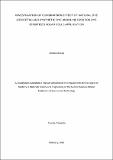| dc.contributor.author | Msangi, Abdala | |
| dc.date.accessioned | 2019-05-31T06:30:31Z | |
| dc.date.available | 2019-05-31T06:30:31Z | |
| dc.date.issued | 2019-02 | |
| dc.identifier.uri | https://doi.org/10.58694/20.500.12479/272 | |
| dc.description | A Dissertation Submitted in Partial Fulfillment of the Requirements for the Degree of Master’s in Materials Science and Engineering of The Nelson Mandela African Institution of Science and Technology | en_US |
| dc.description.abstract | Dye-sensitized solar cells (DSSCs) are reckoned as emerging next-generation solar cells of a high potency. Co-sensitization of dyes facilitates widening of the light absorption range of a sensitizer and is one of possible options to improve overall DSSC performance. In this work, an effect of combination of the natural crocetin dye and synthetic metal free indoline D205 dye was studied. Molecular design of a complex formed from the individual dyes was attempted. The structures, vibrational and electronic spectra of the species were computed by DFT and TD-DFT B3LYP5 methods with mid-sized basis sets. The UV-vis absorption spectra were measured for individual dyes and their mixtures in chloroform solutions. Electron density distribution of the frontier molecular orbitals and energy levels alignment were used for analysis of the electronic spectra and mechanism of transitions. The results indicated that the designed complex can be considered as a potential candidate for DSSCs application with improved properties compared to the individual dyes. | en_US |
| dc.language.iso | en_US | en_US |
| dc.publisher | NM-AIST | en_US |
| dc.subject | Research Subject Categories::FORESTRY, AGRICULTURAL SCIENCES and LANDSCAPE PLANNING | en_US |
| dc.title | Investigation of combination effect of natural dye (crocetin) and synthetic dye (indoline d205) for dye sensitized solar cells application | en_US |
| dc.type | Thesis | en_US |

